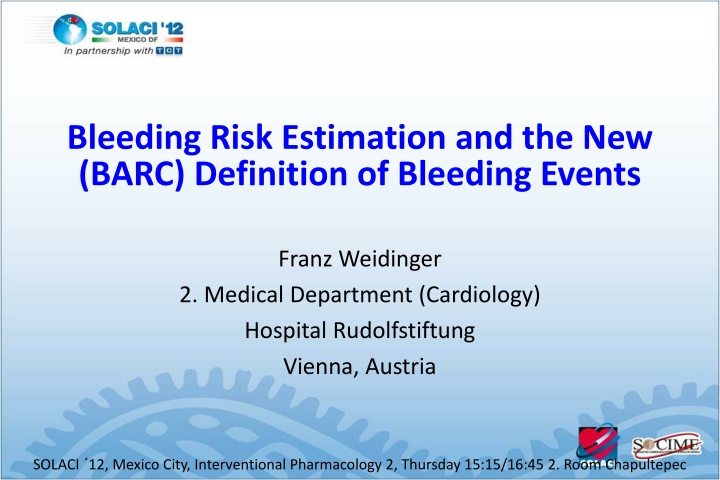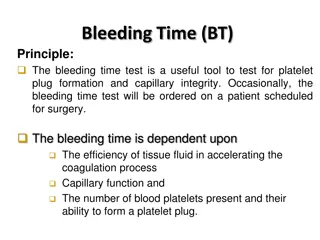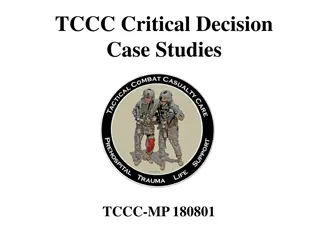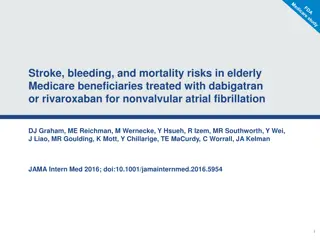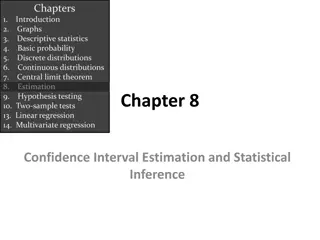Bleeding Risk Estimation and New BARC Definition Overview
This presentation discusses the significance of bleeding as a clinical endpoint in the context of antithrombotic therapy, emphasizing the association between increased bleeding risk and adverse clinical outcomes. It explores hypothetical mechanisms linking bleeding events to mortality and the construction of bleeding definitions using various data elements. The need for a standardized bleeding definition is highlighted to ensure accurate assessment and comparison in research studies and registries.
Download Presentation

Please find below an Image/Link to download the presentation.
The content on the website is provided AS IS for your information and personal use only. It may not be sold, licensed, or shared on other websites without obtaining consent from the author.If you encounter any issues during the download, it is possible that the publisher has removed the file from their server.
You are allowed to download the files provided on this website for personal or commercial use, subject to the condition that they are used lawfully. All files are the property of their respective owners.
The content on the website is provided AS IS for your information and personal use only. It may not be sold, licensed, or shared on other websites without obtaining consent from the author.
E N D
Presentation Transcript
Bleeding Risk Estimation and the New (BARC) Definition of Bleeding Events Franz Weidinger 2. Medical Department (Cardiology) Hospital Rudolfstiftung Vienna, Austria SOLACI 12, Mexico City, Interventional Pharmacology 2, Thursday 15:15/16:45 2. Room Chapultepec
Relevance of bleeding as a clinical endpoint Availability of potent antithrombotic therapy including ASA P2Y12 inhibitors (clopidogrel, prasugrel, ticagrelor) heparin GP IIb/IIIa inhibitors direct thrombin inhibitors has led to a reduction in ischemic events but is associated with an increased risk of bleeding the increase in bleeding is associated with worse clinical outcome
All antithrombotic agents (except fondaparinux, bivalirudin) are associated with increased bleeding risk Aspirin and heparin reduce death/ MI at 30 days in NSTE-ACS
Hypothetical mechanisms linking bleeding and mortality Steg P G et al. Eur Heart J 2011;32:1854-1864
Construction of bleeding definitions using different categories of data elements Rao & Mehran, Circulation 2012;125:1344-1346
Existing bleeding scores TIMI GUSTO GRACE CURE ACUITY Major (intracranial/-ocular, access-site, retroperit.), lab REPLACE-2 ISAR-REACT 3 PLATO STEEPLE CURRENT-OASIS Laboratory-based (hemoglobin, hematocrit decrease) Clinical (severity)-based Simplifiedlaboratory and clinical Major/ minor (combined clin. + lab) Thrombolysis/ conservative PCI-based
Rationale for a new bleeding definition Increased importance of bleeding as prognostic factor Need for assessment of bleeding in RCTs and registries Lack of comparability Need for standardized definitions to avoid erroneous conclusions regarding safety of a given agent regarding superiority of one agent over another
BARC (Bleeding Academic Research Consortium) definitions, Mehran et al, Circulation 2011;123:2736-2747 Type 0: no evidence of bleeding Type 1: bleeding that is not actionable, without need for hospitalization or treatment (e.g. bruising, hematoma, nosebleeds, etc.) Type 2: any clinically overt sign of hemorrhage that is actionable but does not meet criteria for type 3, 4 or 5. Must meet at least 1 of following criteria: Requires intervention Leads to hospitalization Prompts evaluation
BARC (Bleeding Academic Research Consortium) definitions, Mehran et al, Circulation 2011;123:2736-2747 Type 3: clinical, laboratory, and/or imaging evidence of bleeding, with healthcare provider responses: BARC type 3a: any transfusion with overt bleeding overt bleeding plus hemoglobin drop 3 to <5 g/dL BARC type 3b: overt bleeding plus hemoglobin drop >5 g/dL Cardiac tamponade Bleeding requiring surgical intervention for control (excluding dental/nasal/skin/hemorrhoid) Bleeding requiring intravenous vasoactive drugs BARC type 3c: Intracranial hemorrhage, subcategories confirmed by autopsy, imaging or lumbar puncture Intraocular bleed compromising vision
BARC (Bleeding Academic Research Consortium) definitions, Mehran et al, Circulation 2011;123:2736-2747 Type 4:Coronary Artery Bypass Graft related bleeding Perioperative intracranial bleeding within 48 hours Reoperation after closure of sternotomy for the purpose of controlling bleeding Transfusion of 5 U whole blood or packed red blood cells within a 48-hour period Chest tube output 2 L within a 24-hour period Notes: If a CABG-related bleed is not adjudicated as at least a type 3 severity event, it will be classified as not a bleeding event. If a bleeding event occurs with a clear temporal relationship to CABG (ie, within a 48-hour time frame) but does not meet type 4 severity criteria, it will be classified as not a bleeding event. Type 5: Fatal bleeding
Type 5 fatal bleeding Probable fatal bleeding (type 5a) bleeding that is clinically suspicious as the cause of death, but the bleeding is not directly observed and there is no autopsy or confirmatory imaging. Definite fatal bleeding (type 5b) bleeding that is directly observed (by either clinical specimen [blood, emesis, stool, etc] or imaging) or confirmed on autopsy BARC fatal bleeding is meant to capture deaths that are directly due to bleeding with no other cause. The time interval from the bleeding event to the death should be considered with respect to likely causality, but there is no specific time limit proposed.
Type 2 bleeding - further explanations Requires intervention: defined as a healthcare professional guided medical treatment or percutaneous intervention to stop or treat bleeding, including temporarily or permanently discontinuing a medication or study drug Examples include coiling, compression, use of reversal agents (Vit. K, protamine), local injections to reduce oozing, or a temporary/permanent cessation of antiplatelet, antithrombin, or fibrinolytic therapy
Type 2 bleeding - further explanations Leads to hospitalization or an increased level of care: defined as leading to or prolonging hospitalization or transfer to a hospital unit capable of providing a higher level of care Prompts evaluation: defined as leading to an unscheduled visit to a healthcare professional resulting in diagnostic testing (laboratory or imaging). Examples include, but are not limited to, hematocrit testing, hemoccult testing, endoscopy, colonoscopy, computed tomography scanning, or urinalysis.
Open questions regarding BARC Why 48-hour window for CABG-related bleeding? Why type 1 not actionable when patient may take action such as discontinuing medication (with potentially serious consequences such as ST)? Why consider intraocular bleed equivalent to intracranial bleed for BARC 3c? Type 1 bleed subject to misinterpretation by the patient Hicks et al (editorial), Circulation 2011;123:2664
Predictors of bleeding in acute coronary syndrome Age, female sex, renal insufficiency, history of bleeding, use of invasive procedures, lower body weight are powerful predictors of bleeding in ACS Steg P G et al. Eur Heart J 2011;32:1854-1864
Validation of the BARC bleeding definitions in patients with CAD undergoing PCI (pooled analysis of 12,459 pts of 6 RCTs) Comparison of bleeding definitions: BARC TIMI REPLACE-2 Bleeding confirmed as independent predictor of death All 3 definition criteria improved prediction Comparable predictivity of all 3 definitions with respect to 1-year mortality Ndrepepa G et al., Circulation 2012;125:1424-1431
Conclusion BARC is a new objective, hierarchically graded classification of bleeding (Mehran, Circulation [June 14] 2011:123:2736) BARC is based on consensus rather than data-driven Prospective validation is warranted across the spectrum of IHD across management strategies (conservative, invasive) in the context of all invasive procedures (PCI, CABG, endovascular, TAVI)
Conclusion (2) Final validation of BARC and proof of its utility depend on its use by all future RCTs as common safety endpoint unanimous assessment procedure (questionnaires) More important than using one or the other bleeding risk score is the agreement and commitment among clinical trialists to use the same score for comparability of data!
